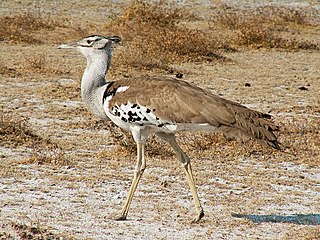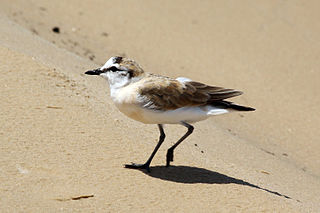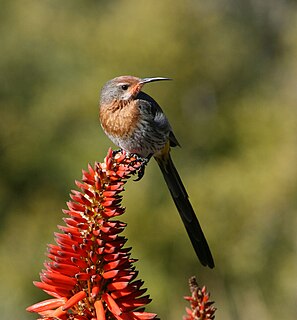
The emu is the second-largest living bird by height, after its ratite relative, the ostrich. It is endemic to Australia where it is the largest native bird and the only extant member of the genus Dromaius. The emu's range covers most of mainland Australia, but the Tasmanian, Kangaroo Island and King Island subspecies became extinct after the European settlement of Australia in 1788. The bird is sufficiently common for it to be rated as a least-concern species by the International Union for Conservation of Nature.

Pica is the genus of seven species of birds in the family Corvidae in both the New World and the Old.

The helmeted guineafowl is the best known of the guineafowl bird family, Numididae, and the only member of the genus Numida. It is native to Africa, mainly south of the Sahara, and has been widely introduced, as a domesticated species, into the West Indies, Brazil, Australia and Europe.

The razorbill or lesser auk is a colonial seabird in the monotypic genus Alca of the family Alcidae, the auks. It is the closest living relative of the extinct great auk. Wild populations live in the subarctic waters of the Atlantic Ocean.

The ocellated turkey is a species of turkey residing primarily in the Yucatán Peninsula, Mexico, as well as in parts of Belize and Guatemala. A relative of the North American wild turkey, it was sometimes previously treated in a genus of its own (Agriocharis), but the differences between the two turkeys are currently considered too small to justify generic segregation. It is a relatively large bird, at around 70–122 cm (28–48 in) long and an average weight of 3 kg (6.6 lb) in females and 5 kg (11 lb) in males.

The African hawk-eagle is a large bird of prey. Like all eagles, it belongs to the family Accipitridae. The African hawk-eagle breeds in tropical Sub-Saharan Africa. It is a bird of wooded hills, building a stick nest about 3 feet in diameter in the fork of a large tree. The clutch is generally one or two eggs. The African hawk-eagle hunts small mammals, reptiles, and birds. The call is a shrill kluu-kluu-kluu.

The southern yellow-billed hornbill is a hornbill found in southern Africa. Yellow-billed hornbills feed mainly on the ground, where they forage for seeds, small insects, spiders and scorpions. This hornbill species is a common and widespread resident of dry thornveldt and broad-leafed woodlands. They can often be seen along roads and water courses.

The blue-footed booby is a marine bird native to subtropical and tropical regions of the eastern Pacific Ocean. It is one of six species of the genus Sula – known as boobies. It is easily recognizable by its distinctive bright blue feet, which is a sexually selected trait. Males display their feet in an elaborate mating ritual by lifting them up and down while strutting before the female. The female is slightly larger than the male and can measure up to 90 cm (35 in) long with a wingspan up to 1.5 m (5 ft).

Kittlitz's plover is a small shorebird in the family Charadriidae that breeds near coastal and inland saltmarshes, sandy or muddy riverbanks or alkaline grasslands with short vegetation. It is native to much of Sub-Saharan Africa, the Nile Delta and Madagascar. It is thought to be mainly monogamous and has monomorphic plumage.

The kori bustard is arguably the largest flying bird native to Africa. It is a member of the bustard family, which all belong to the order Otidiformes and are restricted in distribution to the Old World. It is one of the four species in the large-bodied genus Ardeotis. In fact, the male kori bustard may be the heaviest living animal capable of flight.

The greater rhea is a species of flightless bird native to eastern South America. Other names for the greater rhea include the grey, common, or American rhea; ñandú ; or ema (Portuguese). One of two species in the genus Rhea, in the family Rheidae, the greater rhea is native to Argentina, Bolivia, Brazil, Paraguay and Uruguay. It inhabits a variety of open areas, such as grasslands, savanna or grassy wetlands. Weighing 20–27 kilograms (44–60 lb), the greater rhea is the largest bird in South America. In the wild, the greater rhea has a life expectancy of 10.5 years. It is also notable for its reproductive habits, and for the fact that a population has established itself in Northern Germany in recent years. The species is listed as Near Threatened by the IUCN.

The Maccoa duck is a stiff-tailed diving duck found across Eastern and Southern Africa.

The white-fronted plover or white-fronted sandplover is a small shorebird of the family Charadriidae that inhabits sandy beaches, dunes, mudflats and the shores of rivers and lakes in sub-saharan Africa and Madagascar. It nests in small shallow scrapes in the ground and lays clutches of 1-3 eggs. The species is monogamous and long-lived, with a life expectancy of approximately 11 years. The vast majority of pairs that mate together stay together during the following years of breeding and retain the same territory. The white-fronted plover has a similar appearance to the Kentish plover, with a white fore crown and dark bands connecting the eyes to the bill.

The Madagascan plover, also known as the black-banded plover, is a small monogamous shorebird in the family Charadriidae, native to western Madagascar. It inhabits shores of lagoons, coastal grasslands, and breeds in salt marshes. These plovers mainly nest in open grassland and dry mudflats surrounding alkaline lakes. The species is classified as vulnerable by the IUCN because of its low breeding success, slow reproductive rate, and weak adaptation to increasing habitat loss, leading to declining population numbers.

The rufous-eared warbler is a species of bird in the family Cisticolidae. It is found in Botswana, Namibia, and South Africa. It is the only species in the genus Malcorus. Its natural habitats are subtropical or tropical dry shrubland and subtropical or tropical dry lowland grassland.

Gurney's sugarbird is a medium-sized passerine endemic to the mid- and high-altitude grassland velds in southern Africa. It belongs to the family Promeropidae, which contains one genus, Promerops, and two species. Gurney's sugarbird feeds on nectar from Protea bushes as well as on small insects. This bird is characterized by its long, graduated tail and decurved beak.

The term seabird is used for many families of birds in several orders that spend the majority of their lives at sea. Seabirds make up some, if not all, of the families in the following orders: Procellariiformes, Sphenisciformes, Pelecaniformes, and Charadriiformes. Many seabirds remain at sea for several consecutive years at a time, without ever seeing land. Breeding is the central purpose for seabirds to visit land. The breeding period is usually extremely protracted in many seabirds and may last over a year in some of the larger albatrosses; this is in stark contrast with passerine birds. Seabirds nest in single or mixed-species colonies of varying densities, mainly on offshore islands devoid of terrestrial predators. However, seabirds exhibit many unusual breeding behaviors during all stages of the reproductive cycle that are not extensively reported outside of the primary scientific literature.

The yellow-crowned bishop is a species of passerine bird in the family Ploceidae native to Africa south of the Sahara. It is highly sexually dimorphic in its breeding season, during which the male adopts a distinctive yellow and black plumage, contrasting with the female's predominantly brown coloration. Three subspecies are recognised.

The African hoopoe is a species of hoopoe in the family Upupidae. Previously considered as a subspecies of the hoopoe, due to its vocalisations and small differences in plumage, it is otherwise similar to that species.

The Masai ostrich, also known as the East African ostrich is a red-necked subspecies variety of the common ostrich and is endemic to East Africa. It is one of the largest birds in the world, second only to its sister subspecies Struthio camelus camelus. Today it is hunted and farmed for eggs, meat, and feathers.



















